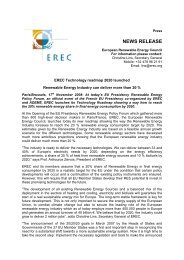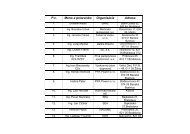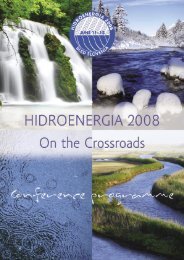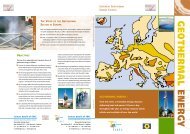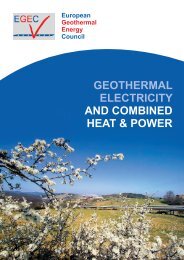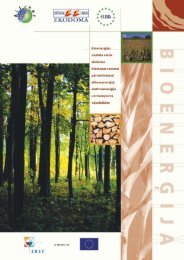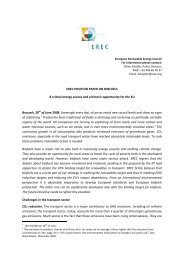CTO Assessment - European Commission
CTO Assessment - European Commission
CTO Assessment - European Commission
You also want an ePaper? Increase the reach of your titles
YUMPU automatically turns print PDFs into web optimized ePapers that Google loves.
PV Roof top systems<br />
Individual houses, Apartments, Buildings,<br />
Schools, Tourism, Sport Facilities<br />
Combined heat and power<br />
small scale 20 MW<br />
Dwellings heated by biomass<br />
individual domestic heating (logwood,<br />
woodchip, pellet systems)<br />
central heating units<br />
district heating plants<br />
Biogas installations<br />
large centralised plants<br />
farm scale plants<br />
Biofuels<br />
Type of Community<br />
Considering that, in addition to the<br />
key sectors, a stated goal of the <strong>CTO</strong><br />
as presented in the White Paper was<br />
the identification of “100 communities”<br />
aiming at 100% of RES supply,<br />
this criterion was introduced to include<br />
those initiatives representative<br />
of the different categories into which<br />
the “100 communities” are subdivided:<br />
Urban communities: they include<br />
projects and programmes of interest<br />
already developed: blocks of buildings,<br />
neighbourhoods in residential<br />
areas, villages, towns, large cities.<br />
Rural communities: programmes developed<br />
in small rural areas, provinces,<br />
and regions.<br />
Isolated communities: isolated areas,<br />
islands (small, medium, large), and<br />
autonomous areas, acting as laboratories<br />
for feasibility analysis and development<br />
of experiences aiming at<br />
100% RES.<br />
Dimension and Geographical coverage<br />
The idea to reach the highest<br />
representativity of EU Member States<br />
was based not only on a criterion of<br />
proportional distribution, but it also<br />
complied with the need to show different<br />
realities of both market conditions<br />
and potential resources within<br />
the <strong>European</strong> Union. Furthermore, a<br />
number of initiatives were chosen from<br />
Central and Eastern <strong>European</strong><br />
Countries.Territorial dimension was<br />
also taken into account in the selection<br />
process, through including reference<br />
actions at national, regional,<br />
and local levels. The most appropriate<br />
territory for each segment was also<br />
identified.<br />
Type of Partnership<br />
and actors involved<br />
This criterion of selection aimed to<br />
guarantee a wide representation of<br />
initiatives, according with the type of<br />
partnership and the variety of different<br />
actors capable to take part in each<br />
process: industry (including utilities<br />
and energy service providers, oil companies<br />
and manufacturers), RES developers,<br />
national and regional governments,<br />
local authorities, energy<br />
agencies, authorities in charge of<br />
public procurement, consultants, engineers,<br />
architects, planners, farmer<br />
associations and co-operatives, associations<br />
and agents of relevant sectors<br />
(industry, tourism, services), nongovernmental<br />
associations, financial<br />
institutions...<br />
Other initiatives were selected because<br />
of the specific interest they have<br />
with regard to the creation of new<br />
partnerships in favour of RES, such<br />
as those in the tourism sector or the<br />
emerging water-energy binomial.<br />
Actions and actors involved in RES<br />
promotion have been taken into account<br />
as an independent segment.<br />
Criteria concerning content<br />
With regard to the contents of each<br />
programme, project and initiative, the<br />
following quantitative and qualitative<br />
aspects have been considered as selective<br />
criteria:<br />
Substantial RES development: The<br />
initiative contributed significantly<br />
to RES development and/or has<br />
given a positive impetus in the respective<br />
area.<br />
Energy and environmental impacts:<br />
Obtention of environmental benefits<br />
or correction of impacts, including<br />
best practices of integration.<br />
Replication potential: The initiative<br />
can be relatively easily replicated,<br />
especially those bringing new solutions<br />
for sectors with great potential.<br />
The approach can be adapted<br />
to different contexts; the initiative<br />
is of model character and can serve<br />
as an example for other actors who<br />
are potentially interested to take<br />
action in the field of RES in general<br />
or a specific technology in particular.<br />
Strong involvement of target group<br />
or direct impact on society: The people<br />
concerned by the initiative are<br />
involved in the project. The degree<br />
of implication is evaluated.<br />
Visibility of approach: The initiative<br />
is presented in a highly visible<br />
way and it is well documented, so<br />
that it is possible for other interested<br />
parties to obtain information<br />
and have access to its follow-up.<br />
Innovative financing concept: The<br />
financing aspect of the initiative is<br />
clear and innovative.<br />
Barriers: Development of projects<br />
giving important information on existing<br />
barriers and their possible<br />
overcoming.<br />
Selection and evaluation<br />
More than 300 cases throughout Europe<br />
have been analysed in the first<br />
phase of the selection process. Those<br />
initiatives illustrate most relevant<br />
actions (projects, programmes and<br />
initiatives) with high replication potential<br />
and measurable results, taken<br />
at the different levels, that contribute<br />
to speed up RES market penetration<br />
in Europe. Through a matrix appli-<br />
24<br />
<strong>CTO</strong> - References



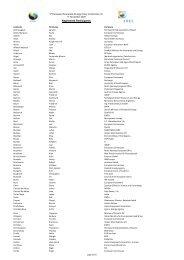
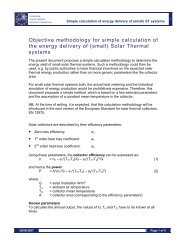
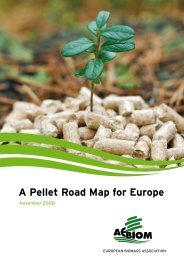
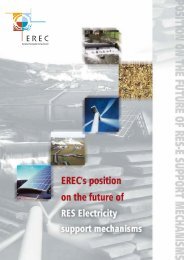

![Energy [R]evolution - Greenpeace](https://img.yumpu.com/47174859/1/184x260/energy-revolution-greenpeace.jpg?quality=85)
